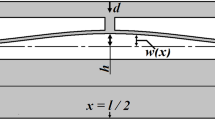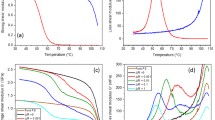Abstract
A majority of the current experimental techniques for measuring damping employ either flexural or torsional vibrations.In either case the strain field is nonhomogeneous. If the material damping is linear, i.e., strain independent, then the measured quantity equals the intrinsic material damping. if, on the other hand, the material damping is nonlinear, i.e., strain dependent, then the measured quantity also reflects the nonhomogeneity of the strain field and, therefore, is not equal to the intrinsic material damping. In this work we describe a new experimental technique in which the foregoing problem is circumvented by employing a homogeneous strain field, namely, uniform uniaxial tension. Damping is viewed as the phase angle by which the stress leads the strain. The finiteduration, time-harmonic stress and strain signals are transformed to the frequency domain via the use of Fourier transforms. It is shown that if one confines attention to the immediate neighborhood of the excitation frequency then, for all practical purposes, the phase difference between the two sinusoids is equal to the phase difference between their Fourier transforms. We will demonstrate that this phase difference can be measured to an accuracy of 2π/216 or 9.587×10−5 radians.
Similar content being viewed by others
References
Lazan, B.J., Damping of Materials and Members in Structural Mechanics, Pergamon Press, Oxford (1968).
Bejan, A., Advanced Engineering Thermodynamics, John Wiley and Sons, New York (1988).
Gibson, R.F., “Recent Research on Dynamic Mechanical Properties of Fiber Reinforced Composite Materials and Structures,”Shock and Vib. Dig.,15 (2), (Feb. 1983).
Lin, C.H. andPlunkett, R., “A Low-Frequency Axial Oscillation Technique for Composite Material Damping Measurement,”J. Comp. Mat.,23,92–105 (Jan. 1989).
Sneddon, I.H., The Use of Integral Transforms, McGraw-Hill (1972).
Micro-Measurements M-Bond 600 adhesive is a two-part epoxyphenolic thermosetting epoxy capable of glue lines less than 0.005-mm thick.
Ramirez, R.W., “The FFT: Fundamentals and Concepts,”Textronix Incorporated, Beaverton, OR (1975).
Wren, G.G. andKinra, V.K., “An Experimental Technique for Determining a Measure of Structural Damping”,J. Test. and Eval.,16 (1),77–85 (1988).
Author information
Authors and Affiliations
Rights and permissions
About this article
Cite this article
Kinra, V.K., Wren, G.G. Axial damping in metal-matrix composites. I: A new technique for measuring phase difference to 10−4 radians. Experimental Mechanics 32, 163–171 (1992). https://doi.org/10.1007/BF02324728
Received:
Revised:
Issue Date:
DOI: https://doi.org/10.1007/BF02324728




